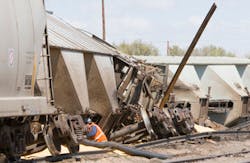About 60 people are believed to have died after the huge explosion of a train carrying oil from the Bakken oil region in North Dakota to a refinery on the east coast of Canada. The train derailed in Lac-Mégantic in Quebec on July 6, causing a deadly blast that destroyed at least 30 buildings.
Huge fireballs erupted from the derailed train and 2,000 people had to be evacuated from their homes as a precaution. It was announced that terrorism had been ruled out as a possible cause of the incident. While an official investigation is still underway, Edward Burkhardt, head of U.S.-based company Rail World, which operated the train, commented that the disaster was most likely caused by human error, as he believed the hand brakes were not properly applied. He explained that the engineer in charge of driving the train had been suspended without pay.
About 200 police officers and officials from various agencies have been investigating onsite and the town center is being treated as a crime scene, the BBC reported. Data gathered from the train's data recorders has revealed that the engineer and the train's crew parked the train in Nantes, Quebec, and locked it in place on an uphill slope in the night of July 5. Almost an hour later, a small fire started in one of the train's locomotives and local firefighters were called to extinguish it. A short time afterwards the train's brakes apparently failed, sending the train on a journey downhill with no driver on board. After picking up considerable speed, the train derailed in Lac-Mégantic's town center and the 72 cars of crude oil exploded, causing devastation in town.
RELATED: Energy experts see benefits of rail over pipe in crude transportation
Many opponents of transporting crude by rail have been pointing out that disasters like this one could have been predicted, as not only are there more trains carrying potentially hazardous cargo but these trains are also getting longer. According to data obtained by the Global Post, Canadian railway companies transported a total of 86,000 carloads of petroleum products in the second quarter of 2013, up 18 percent from last year and 62 percent from 2011.
The problem is even more serious when shipping of explosive chemicals by rail is considered. The total amount of chemicals transported by rail over the same period is 154,000 carloads. Experts say that some chemical substances are more powerful and could cause even more damage than crude in case of an incident. It is expected that a review of safety regulations will be conducted in the aftermath of the Lac-Mégantic disaster but it is unlikely that any significant changes will be made as they would harm the industry, experts commented.
However, according to the American Association of Railroads, 99.9977 percent of all shipments of hazardous materials are safely delivered to their destination. Accident rates have dropped by 91 percent since 1980 and are still falling, the Global Post reported. Moreover, the estimated spill rate of crude by rail is 0.38, compared with 0.88 for pipelines, officials at the American Association of Railroads claimed.
